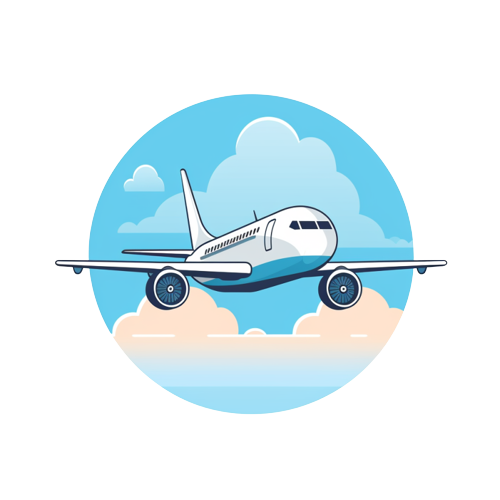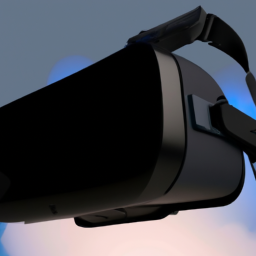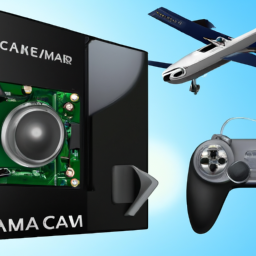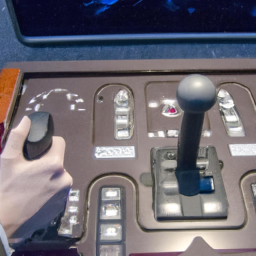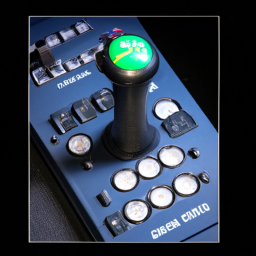In this article, we’ll explore the possibility of using VR (Virtual Reality) for flight simulation. We’ll discuss the advantages and limitations of using VR technology in this context and help you understand whether it is a viable option for your flight training needs. By the end, you’ll have a clear understanding of the potential benefits and considerations of using VR for flight simulation.
What is VR (Virtual Reality)?
Definition of VR
Virtual Reality (VR) is an immersive technology that simulates an artificial environment and allows users to interact with and navigate through it. With VR, users can experience a realistic and lifelike environment that feels as though they are physically present within it. This technology typically involves the use of headsets or goggles along with motion-tracking devices to track the user’s movements and provide a 360-degree view of the virtual world.
How VR works
VR works by creating a virtual environment using computer-generated imagery (CGI) or by capturing real-world scenes through 360-degree cameras. The virtual environment is then presented to the user through a head-mounted display (HMD) or a smartphone inserted into a VR headset. These displays produce stereoscopic images that create the illusion of depth and immersion.
To provide a more interactive experience, VR systems use peripherals such as controllers or gloves that allow users to manipulate objects or perform actions within the virtual environment. Some VR experiences also incorporate haptic feedback devices that provide a sense of touch, further enhancing the realism of the virtual world.
Applications of VR
VR technology has found applications in various industries, including gaming, entertainment, education, healthcare, and training. One of the areas where VR has shown great potential is flight simulation.
Overview of Flight Simulation
Purpose of flight simulation
Flight simulation is a crucial part of pilot training and aircraft development. It allows pilots to practice their skills in a controlled environment, gaining valuable experience and developing muscle memory without the risks associated with real-world flying. Flight simulation also plays a vital role in aircraft design and testing, allowing engineers to analyze how aircraft respond to different conditions and scenarios.
Types of flight simulators
Flight simulators come in different forms, ranging from simple desktop computer programs to full-scale replicas of cockpit interiors. They can be categorized into two main types: hardware-based simulators and virtual simulators.
Hardware-based simulators consist of physical replicas of aircraft cockpits equipped with realistic controls, switches, and instruments. These simulators provide a high level of realism but can be costly and require dedicated space for installation.
Virtual simulators, on the other hand, rely on computer software to create the virtual environment and simulate aircraft operations. They are more accessible and cost-effective compared to hardware-based simulators, making them popular choices for pilot training and aircraft research.
Benefits of flight simulation
Flight simulation offers several benefits, regardless of the type of simulator being used. It allows pilots to practice and refine their skills in various scenarios, including emergency situations and adverse weather conditions. Simulators also provide a safe environment for pilots to learn and experiment without risking their lives or damaging aircraft.
For aircraft development, simulators enable engineers to test new designs and systems virtually, saving time and resources compared to physical prototypes. Flight simulation also allows for the evaluation of human factors in aircraft operations, such as pilot workload and decision-making, leading to improvements in safety and efficiency.
Advancements in VR Technology
Evolution of VR in recent years
VR technology has significantly evolved in recent years, becoming more accessible, affordable, and immersive. With advancements in graphics processing power and display resolution, VR headsets now offer higher-quality visuals and more realistic environments.
In addition to improved visuals, VR systems now incorporate spatial audio technology, enhancing the user’s sense of immersion by providing realistic sounds that are accurately positioned in the virtual environment. This audio enhancement further contributes to the overall experience and realism of VR simulations.
Improved hardware and software
Both hardware and software advancements have contributed to the improvement of VR for flight simulation. Headsets have become more comfortable, lighter, and offer better ergonomics, ensuring prolonged use without causing discomfort or fatigue. Controllers and haptic feedback devices have also become more precise, allowing for more realistic interaction within the virtual environment.
On the software side, developers have created sophisticated flight simulation programs that accurately replicate the physics and mechanics of aircraft. These programs simulate various scenarios and environmental conditions, providing pilots with a comprehensive training experience. Additionally, virtual reality software development kits (SDKs) have made it easier for developers to create immersive and realistic VR experiences.
Enhanced user experience
With advancements in VR technology, the user experience has become more immersive and engaging. VR systems can now track the user’s movements and translate them into the virtual environment in real-time, enabling users to walk, run, or interact with objects in the virtual world.
The increased field of view and reduced motion-to-photon latency in modern VR headsets have minimized the occurrence of motion sickness, a common issue experienced in early VR systems. These developments have made VR more comfortable and accessible to a wider range of users.
Integration of VR and Flight Simulation
Benefits of using VR in flight simulation
The integration of VR technology into flight simulation offers numerous advantages. Firstly, it provides a more realistic visual experience, allowing pilots to feel as though they are sitting in the cockpit of an actual aircraft. The immersive nature of VR helps pilots become familiar with the controls, instruments, and overall cockpit layout, which translates into better performance in real-world flying.
Using VR in flight simulation also enhances the training effectiveness. Pilots can practice complex maneuvers, emergency procedures, and instrument flying in a safe and controlled environment. The ability to simulate various scenarios and environmental conditions prepares pilots for real-world challenges, improving their decision-making skills and confidence.
Realistic visual and immersive experience
One of the significant advantages of using VR in flight simulation is the level of realism it offers. VR headsets provide users with a 360-degree panoramic view of the virtual environment and accurately replicate the depth perception that is crucial for flying an aircraft.
Being able to look around and perceive the spatial relationships between different objects and instruments in the cockpit enhances situational awareness. This allows pilots to quickly interpret and respond to visual cues, ultimately improving their flying skills and safety margins.
The immersive experience provided by VR also contributes to the effectiveness of training. Pilots can feel a sense of presence within the virtual environment, making the training sessions more engaging and memorable. This level of immersion helps pilots retain information and transfer their skills to real-world flying more effectively.
Increased training effectiveness
The use of VR in flight simulation has been proven to increase training effectiveness and efficiency. VR systems can replicate any scenario or environmental condition, allowing pilots to practice in challenging and high-risk situations that might be impractical or dangerous to simulate in the real world.
Simulating emergencies, system failures, and adverse weather conditions prepares pilots for unexpected situations, helping them develop the necessary skills to handle them calmly and effectively. The ability to repeat training scenarios and receive immediate feedback allows pilots to identify and correct mistakes, accelerating the learning process.
Moreover, the immersive nature of VR training enhances muscle memory development, as pilots physically perform actions within the virtual environment. This muscle memory can significantly improve response times and accuracy during real-world flight operations.
Challenges and Limitations of VR for Flight Simulation
Simulator sickness and motion sickness
One of the primary challenges associated with VR for flight simulation is the occurrence of simulator sickness and motion sickness. Simulator sickness refers to the symptoms of discomfort, dizziness, and nausea that some individuals experience when using VR systems for an extended period. Motion sickness, on the other hand, occurs due to a conflict between the visual information provided by the VR headset and the body’s vestibular system, which senses motion and balance.
To mitigate these issues, VR developers are continuously improving the technology, reducing latency, increasing refresh rates, and refining motion-tracking algorithms. Adjustments to the virtual environment, such as reducing motion blur and utilizing proper scaling, can also minimize the occurrence of simulator sickness. However, it is essential for users to take regular breaks and acclimate themselves to VR gradually to avoid discomfort.
Cost and accessibility
While VR technology has become more affordable over the years, it can still represent a significant investment, especially for high-end VR headsets and hardware. Flight simulation setups that incorporate VR can be even more costly, as they require powerful computers, realistic controls, and peripherals.
Furthermore, the accessibility of VR for flight simulation is still limited. Not all training centers or flight schools have the resources or infrastructure to implement VR systems. This can make it challenging for aspiring pilots to access VR-based flight training, potentially widening the gap between those who can afford it and those who cannot.
Technical limitations
VR technology, although advanced, still has several technical limitations that can affect its application in flight simulation. These limitations include visual fidelity, resolution, and field of view. While VR headsets have improved significantly in these aspects, they are still inferior to human vision clarity and detail.
Another technical limitation is the need for a powerful computer and graphics card to run VR simulations smoothly. The high processing requirements can limit the performance and accessibility of VR systems, as not all users may have access to such hardware.
Training and Safety Considerations
VR as a supplementary training tool
When considering the use of VR for flight simulation, it is crucial to view it as a supplementary training tool rather than a complete replacement for traditional flight training. While VR can provide realistic visual and immersive experiences, it cannot fully replicate the physical sensations and forces experienced during real-world flying.
Therefore, VR should be used in conjunction with traditional flight training methods, such as actual flight hours and classroom instruction. This blended approach allows pilots to benefit from the strengths of both VR and real-world training, ensuring a comprehensive and well-rounded learning experience.
Risk mitigation in VR-based flight simulation
Safety is paramount in aviation, and the same holds true for VR-based flight simulation. To ensure safe training sessions, it is essential to conduct thorough risk assessments and implement appropriate safety measures.
Incorporating safety protocols, such as limitations on the duration of VR sessions and implementing adequate breaks, can help reduce the risk of simulator sickness and motion sickness. Training centers should also ensure that VR equipment is properly maintained and regularly calibrated to avoid technical issues that could jeopardize safety.
Additionally, flight instructors and supervisors play a crucial role in monitoring and guiding pilots during VR-based training sessions. Their expertise and oversight help identify and correct potential errors or misconceptions, ensuring that the training remains accurate and effective.
Training program design
Designing an effective VR-based training program requires careful consideration of training objectives, learning outcomes, and curriculum structure. Training programs should be structured to gradually introduce VR technology, starting with basic scenarios and progressing to more complex and realistic simulations.
Providing clear guidance and instructions on the use of VR equipment and software is essential to ensure pilots receive the maximum benefit from their training. Regular evaluation and feedback from instructors and supervisors can help tailor the training program to individual needs and address any areas for improvement.
Regulatory and Certification Requirements
Regulations for using VR in flight training
The use of VR in flight training is subject to regulatory oversight to ensure compliance with safety and training standards. Regulatory bodies, such as aviation authorities, impose guidelines and requirements for the use of VR technology in pilot training programs.
These regulations primarily focus on ensuring that VR-based training remains consistent with the established training standards. They may include guidelines on the use of VR equipment, training curricula, and instructor qualifications.
Certification standards for VR flight simulators
In addition to regulations, certification standards have been established to assess the reliability, accuracy, and effectiveness of VR flight simulators. These certification standards, developed by aviation authorities and industry organizations, ensure that VR simulators meet the necessary criteria for training and proficiency assessment.
Certification standards cover various aspects of VR simulators, including hardware specifications, software accuracy, realistic visual rendering, and accurate replication of aircraft systems and dynamics. Meeting these standards demonstrates that VR simulators provide a level of fidelity and performance comparable to traditional flight simulators.
Industry compliance
The aviation industry has shown remarkable compliance with regulatory and certification requirements for VR-based flight training. Flight training organizations, aircraft manufacturers, and aviation authorities have embraced VR technology as a valuable tool for pilot training and aircraft development.
Industry compliance ensures that VR-based flight training programs meet the necessary safety standards and provide consistent and accurate training experiences. Compliance also ensures that pilots trained in VR simulators are adequately prepared for real-world flying, contributing to overall flight safety.
Case Studies and Success Stories
Successful implementation of VR in flight simulation
Numerous flight training organizations, flight schools, and aviation institutions have successfully implemented VR technology in their training programs. These organizations have reported positive outcomes and benefits from the integration of VR in flight simulation.
For example, a flight training academy introduced VR-based flight simulators as part of their instrument rating training program. Pilots-in-training reported increased confidence in instrument flying and improved decision-making skills. The ability to simulate various weather conditions and challenging approaches allowed students to practice in realistic scenarios, better preparing them for real-world operations.
Another success story involves a commercial airline that incorporated VR-based flight training for cockpit procedures and emergency simulations. The airline reported a significant reduction in training costs and improved training outcomes. Pilots were able to practice abnormal procedures and emergency drills without impacting flight schedules or aircraft availability.
Positive outcomes and feedback
Feedback from pilots and flight instructors who have experienced VR-based flight simulation is overwhelmingly positive. Pilots appreciate the realistic visual experience provided by VR systems, as it allows them to familiarize themselves with aircraft controls and instrumentation in a lifelike environment.
Instructors have reported that VR enhances their ability to provide feedback and guidance to pilots. The immersive nature of VR allows instructors to identify specific areas for improvement and provides a shared visual reference for debriefing sessions. This shared experience helps bridge the gap between instructors and pilots, leading to more effective communication and learning.
Real-world applications
The benefits of VR for flight simulation extend beyond training and education. VR technology has been employed in aircraft design and research, allowing engineers to visualize and evaluate cockpit layouts, aircraft ergonomics, and human-machine interfaces.
Furthermore, VR simulations have been used for pre-flight planning, allowing pilots to familiarize themselves with unfamiliar airports, approach procedures, and flight routes. This pre-flight training helps reduce workload and stress in real-world operations, enhancing flight safety and efficiency.
Future Prospects and Trends
Potential advancements in VR for flight simulation
As VR technology continues to evolve, the prospects for its application in flight simulation are promising. Advancements in resolution, field of view, and haptic feedback technologies can further enhance the realism and immersion of VR-based simulations.
Additionally, the integration of artificial intelligence (AI) in VR flight simulators holds great potential. AI algorithms can be employed to create more intelligent virtual environments, allowing for more realistic and dynamic scenarios. AI can also be used to adapt training scenarios to individual pilots’ proficiency levels, providing personalized training experiences.
Integration with artificial intelligence
The integration of AI in VR flight simulators can revolutionize pilot training and aircraft research. AI algorithms can provide intelligent virtual opponents and co-pilots, simulating interactions and scenarios that mimic real-world flying conditions. This integration allows pilots to practice decision-making, crew resource management, and communication skills in a controlled and safe environment.
AI algorithms can also analyze pilot performance data and provide personalized feedback and recommendations for improvement. This individualized training can help pilots address specific weaknesses and enhance their overall proficiency, leading to safer and more effective operations.
Expanding applications in the aviation industry
The application of VR in aviation is not limited to flight training alone. VR technology can be utilized in various areas of the aviation industry, such as maintenance and repair training, air traffic control simulations, and aircraft system familiarization programs.
For maintenance and repair training, VR can simulate complex aircraft systems, allowing technicians to practice troubleshooting and repairs without the need for an actual aircraft. This can reduce maintenance downtime and costs, as well as minimize the risks associated with training on operational aircraft.
Air traffic control simulations using VR can provide realistic scenarios for controllers to practice managing air traffic and making critical decisions. These simulations can help enhance controller skills and resilience, preparing them for the demanding and dynamic nature of their roles.
Conclusion
In conclusion, VR technology holds enormous potential for flight simulation and pilot training. With its realistic visual experience, enhanced immersion, and increased training effectiveness, VR can offer a valuable tool for aspiring pilots and experienced aviators alike.
Despite the challenges and limitations, continuous advancements in VR hardware and software, along with industry compliance, can overcome these obstacles and pave the way for wider adoption of VR in flight simulation. As VR technology continues to evolve, its integration with artificial intelligence and expanding applications in the aviation industry will further enhance its benefits and contribute to the advancement of aviation training and safety.
Let the skies be your playground as you explore the possibilities of using VR for flight simulation. With VR, you can take your training to new heights and embark on a journey towards becoming a skilled and confident pilot. So, can you use VR for flight simulation? The answer is a resounding yes! Buckle up and get ready for an immersive and exhilarating experience in the virtual skies.
